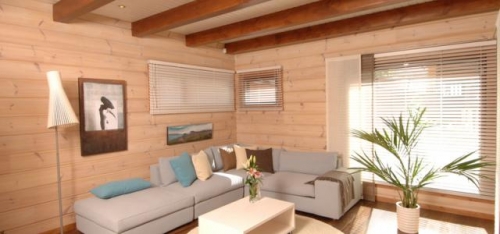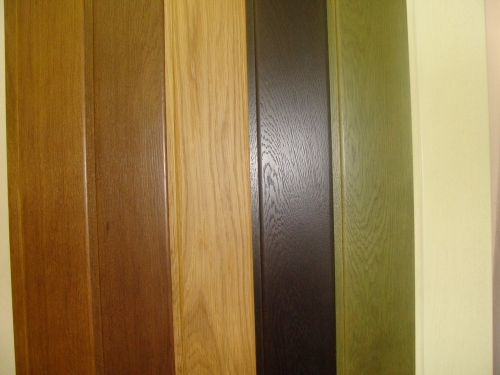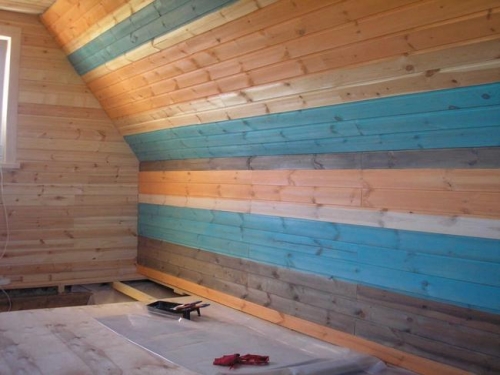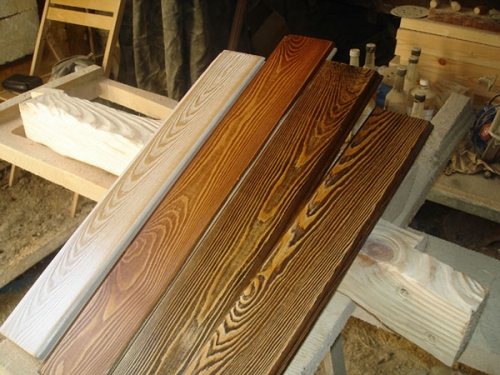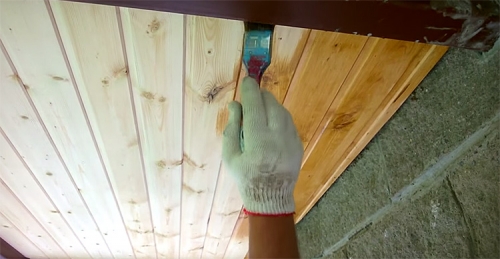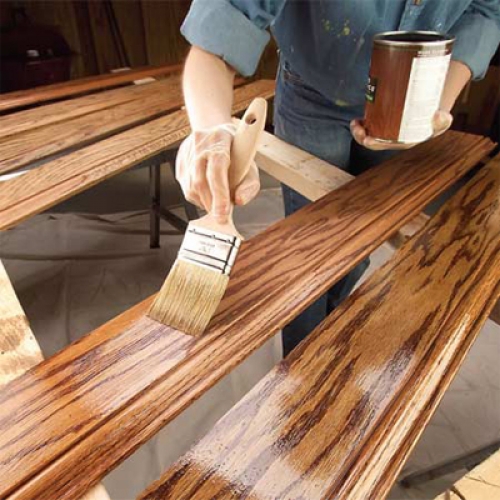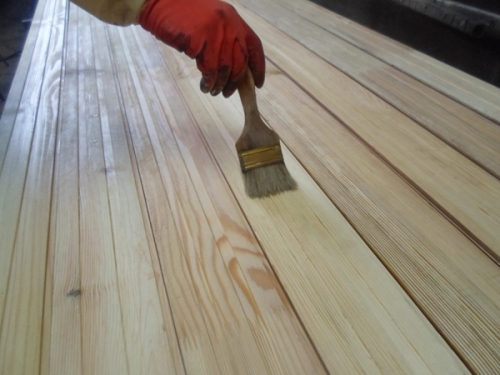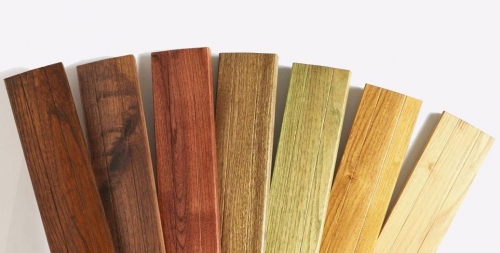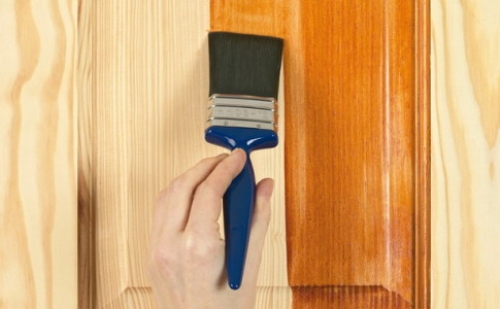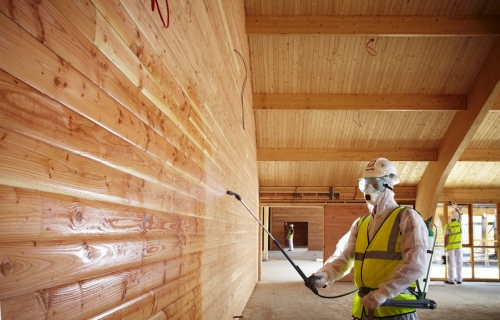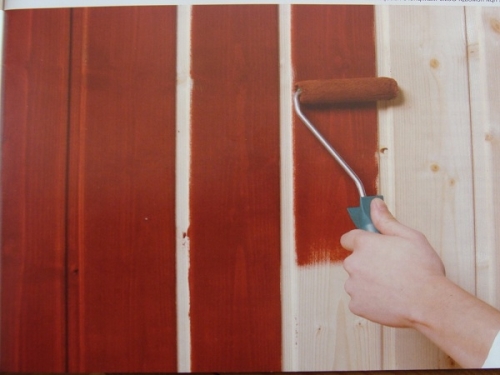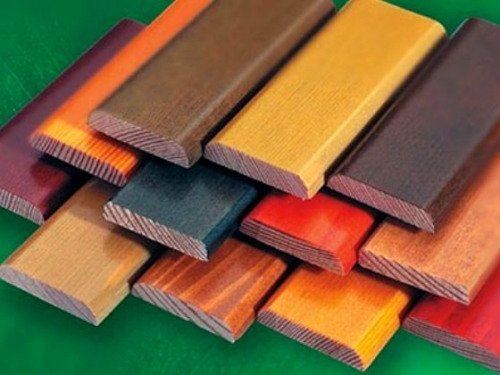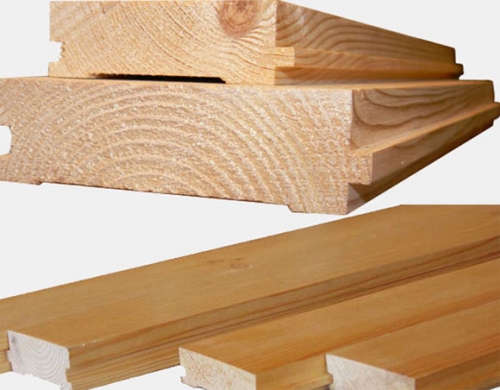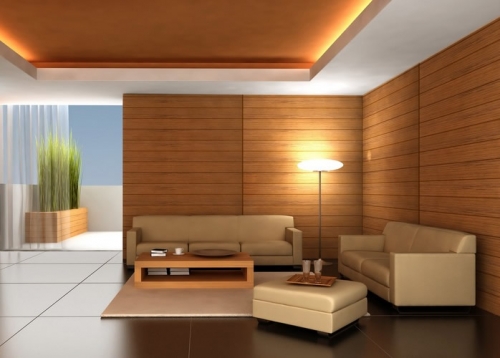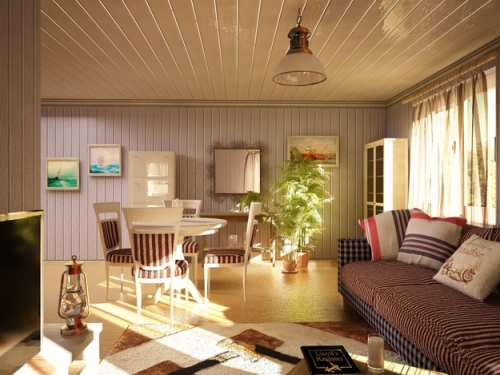The ceiling is filled with siding is an inexpensive and practical option for its repair. Besides,...
|
|
Roofs, for the installation of which asbestos slate are used, for many ... |
The sliding gates become popular and gradually replace standard swing, in ... |
Painting the lining: photo, step -by -step instructions
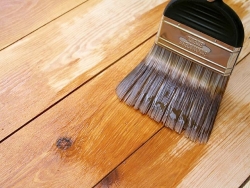
The irrefutable advantages of the tree made it one of the most popular finishing materials even in the era of construction paradise, when each master can choose the material for every taste. It is thanks to low thermal conductivity and other positive qualities, such as the ease of attachment, the ability to hide the surface defects, as well as environmental safety, wooden Eurovarovka has been ensured stable popularity for a long time. The lining is a thin finishing panel of selected wood, designed for external and interior decoration of the premises and performing several functions, among which a special place is given to cosmetic, decorative and soundproofing. Despite the fact that there are several varieties of the lining of wooden and plastic, experienced experts prefer the first option, in view of its significant advantages. In most cases, lining is sheathed the outer side of the house, as well as verandas, loggias and balconies. After wall decoration by lining, which hides their irregularities and other disadvantages, they acquire aesthetically attractive appearance. The use of a wooden lining contributes to the uniform distribution of humidity and the preservation of heat in the room, which, after finishing with this material, is filled with a pleasant wood smell. An ideal option for the interior decoration of the room is a pine, which nature endowed with a pleasant golden tint darkening over time. Despite the fact that theoretically, the lining is a durable material, like any other, it is necessary to properly care, which will extend its service life. The main component of proper care is the painting of the lining that protects the material from drying out, dust and damage to insects, as well as from temperature and humidity drops. Due to the relevance of this question, in this article we will answer the question: how and how to paint the lining inside the house?
Content
- Painting the lining: relevance of the issue
- How to paint the lining: selection of paintwork
- Technology painting lining: step -by -step instructions
- Some useful tips of masters
- How to paint the lining: choosing a color scheme
Painting the lining: relevance of the issue
You can talk for a long time about the advantages of wood as a finishing material. It is characterized by the ability to heat and soundproofing, and the ability to visually hide the irregularities of the surface to be cut, and the simplicity of installation, and, of course, durability. Thus, the lining is characterized by all the advantages characteristic of the tree. However, the tree is also characterized by their drawbacks, such as a tendency to fire, decay, as well as exposure to damage by insects and fungus. In this regard, despite the fact that the lining is durable material, over time it loses its original characteristics. To avoid this, finishing materials made of wood must be ensured by proper care, one of the stages of which is painting a wooden lining.
Important! Painting the lining is the final stage of finishing measures, however, as well as to the implementation of other stages, it is necessary to approach the proper liability. The operational period of the lining and its ability to preserve the initial operational characteristics depends on the selection of the most effective paintwork.
Log photo
How to paint the lining: selection of paintwork
The most susceptible to destruction and aging of the lining, which was used for lining the facades of buildings. This is due to the fact that negative factors of the external environment, such as microorganisms present in the environment and causing wood, ultraviolet radiation, as well as sharp temperature and humidity changes, leading to the reproduction of mold in the environment are constantly influencing it. In this regard, for external decoration, experts recommend using a lining made of coniferous wood, which contains a resin with antiseptic properties and prevents the development of mold and fungus. However, it must also be processed with special compounds to extend the performance. For processing a wooden lining, functional and decorative compositions are used. The first group includes:
- Antipyrene Functional compositions used to reduce the combination of material. Due to the fact that a wooden lining is a fire hazardous material, anti -riveting processing is a mandatory event;
Important! According to experts, the most effectiveness is characterized by the industrial treatment of a wooden lining with antipyrens, which involves the application of a protective composition under high pressure. DIY antipyrene is considered a less effective event.
- Bactericidal and antiseptic compositions, penetrating into the structure of wood to a depth of several millimeters and preventing its destruction under the influence of aggressive environmental factors, such as ultraviolet radiation, atmospheric precipitation, mold and rot. To process a wooden lining inside the house, the compositions are used, on which their purpose for internal work is indicated;
- Olifa The composition that provides reliable protection of wood from decay, as well as giving it water -altered characteristics. However, the disadvantages of olifa, such as an unpleasant odor and a long time of drying of each layer, significantly limit its use;
- Acrylic varnishes Strong paintings with not only functional, but also decorative characteristics. They are used to finish the lining of the lining and are applied in two doses: the first layer involves applying a transparent varnish, and the second varnish with the addition of a tincent composition. The selection of water -based acrylic varnish is ideal for those who want to save the original texture of the material;
- Yacht varnish It forms a reliable and durable coating of a wooden lining that protects the material from humidity, mold and fungus, as well as ultraviolet radiation. In view of the presence of solvents in the varnish, is characterized by an unpleasant, but rapidly weathering smell. Distinguish between matte, half -material and glossy varnishes. The lack of yacht varnish is its high cost, but it is fully consistent with the quality of the composition. In this regard, painting the lining of varnish can be significantly limited;
- Synthetic varnishes Unlike water -based acrylic varnishes, they are more toxic, however, in the process of application, they provide the lining of a rich shine and a smooth surface. Due to the fact that synthetic varnishes include xylol and toluene, it can only be used for external work;
- A profitable alternative to varnishes is considered wax -based compositionsProviding a wagging half -material shine. However, the limiting moment in its use is the complexity of application.
If the first group of funds is focused on protecting the lining from operational factors and extending the terms of its use, then the use of the second group of decorative compositions is relevant if you plan to radically change the design of the room.
Decorative compounds for painting the lining:
- Oil paints, deeply penetrating into the structure of wood and effectively increase its resistance to negative influences of the external environment, including moisture. However, they are characterized by a rather long drying time, as well as gradual loss of color during operation. In addition, the features of the composition of oil paints contribute to the fact that the breathability of wood is reduced, and therefore, they can only be used to paint individual elements indoors;
- Acrylate paints In their operational characteristics, they surpass oil compounds, which guarantees a greater preservation of the color and brilliance of a wooden lining. They are characterized by high elasticity, and therefore, they do not crack even with significant temperature changes and deformations, and painting the lining can be used for both external and internal work;
- Alkyd Allows you to paint the lining in a wide color range both inside and outside the room. After staining a wooden lining on an alkyd basis, a glossy surface is formed on the surface of the material, which over time can fade, which leads to the need for re -staining;
- The paints are water -basedDo not hide the texture of wood, giving it a matte surface. They are characterized by the lack of an unpleasant odor and a quick drying time, but they are inferior in reliability. The construction market offers a wide variety of water -based paint and varnishes, among which facade, waterproof, washable, as well as enamels intended for internal work are distinguished.
Important! For painting a wooden lining in a bath or sauna, professionals recommend choosing special impregnations or varnishes that reliably protect the decorative coating from moisture and dirt, as well as not release harmful volatile components when heated.
Technology painting lining: step -by -step instructions
Regardless of what paint you have chosen, painting a house, a lining in which is the main finishing material, requires compliance with the technology of applying paint for the lining. An important role in this process is given to preparatory measures.
What are the preparatory measures: we prepare the lining for painting
- First of all, it is necessary to clean the lining of the old paint. If a layer of paintwork is kept quite firmly, the painted lining must be cleaned with a 2 % solution of soda, which will help effectively remove the layer of old paint. If fragments of paint still remain on the surface of the lining, they can not be removed, since they make it possible to give the lining a new, original texture;
- After cleaning the lining, it is necessary to grind it, for which it is recommended to use not a specialized grinding machine, but traditional sandpaper or even pumza;
- By grinding, treat the lining with olifa;
Important! To improve the result of the processing of the lining of the Oliphi, add 50 grams of turpentine and dry pigment to its composition, which can be used as a sword or guard;
- The final stage of preparatory measures is a primer for which primer compounds for wood or compositions are used, which will be used for further staining.
Important! Experts recommend replacing the traditional primer with a primer antiseptic, which will increase the protective characteristics of the processed wooden lining to a greater extent. Despite the fact that this preparatory stage is not mandatory, experienced experts do not recommend neglecting them, explaining this by the fact that individual wood in the field of sawn knots have specific formations - resin pockets, of which resin is distinguished from time to time, reducing the protective properties Paints or antiseptic. Currently, manufacturers offer many varieties of primer compounds: for external, for internal work, as well as specialized antifungal and anti -flesed primers that significantly extend the life of the paintwork.
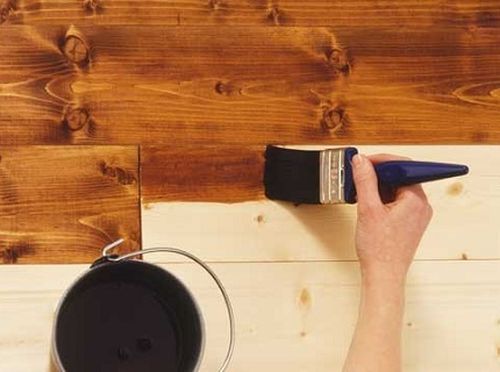
Technology painting lining
- Painting the lining, video instruction to which is attached below, a process that is not difficult and can be carried out even by a newcomer. But, despite this, experts recommend following some tips, which can also be familiar with in this article.
- The application of paint must be carried out with a thin layer, producing continuous movements along the wooden panel. It is important that in the process of painting the lining along its surface only the ends of the bristles of the brush pass, but not its base;
- Even if the paint or varnish does not completely cover the surface of the lining, it is not recommended to apply too thick a layer of paintwork, since several thin layers will provide a longer coating than one thick layer;
- In order to effectively paint the lining in hard -to -reach places, as well as in the area of \u200b\u200bskirting boards and platbands, experts recommend using a thinner brush, the diane of which does not exceed 5 cm;
- The next advice will avoid the appearance of traces on the surface of the just painted lining. To do this, the finish layer of paint must be applied from top to bottom, which will allow the surface of freshly painted lining as efficiently as possible.
Important! In the process of painting vertical surfaces, for the decoration of which a wooden lining was used, the paint layer must be applied continuously. At the same time, it is not recommended to paint the same place more than two to three times, as this will lead to the fact that the painted surface will not be strong enough and acquires a sloppy appearance. In addition, after applying each layer, it is necessary to wait for its drying, and then proceed to apply the subsequent layer of paint.
Some useful tips of masters
- To improve the quality of the color, follow the advice of our specialists.
- Before painting, as well as in the process of work, it is necessary to thoroughly mix the paint, which will achieve the uniformity of color and shine;
- To verify the correctness of the color selection, make a trial painting that involves applying paint to a small section of an unused board;
- To avoid the irregularities of color and shine, experts do not recommend applying too thick a layer of paints and varnishes, replacing it with several thinner layers;
- The next fact may seem amazing to someone, but sometimes, during staining the lining may be required by chigic mittens. Experts explain this by the fact that sometimes a wooden lining can alternate with metal pipes and other metal elements that are difficult to color quite difficult, which is explained by the fact that one side is on the ground. To facilitate the staining process, it is enough to twist the chigic mitt by fur out, put it on the hand and, dipping into the paint, use it instead of a brush. This method significantly accelerates the staining process and allows you to paint up to 5 meters of the pipe in 1 minute;
- Experts recommend that the primer in color, to the greatest extent corresponding to the color of the varnishes used to the most appropriate;
- It is not recommended to produce paints and varnishes in sunny weather or under the influence of direct sunlight, which can excessively accelerate the drying time of the paintwork. To avoid this, do not carry out such measures in hot sunny weather, as well as during precipitation. The most optimal weather for paintwork is warm, cloudy and calm weather;
- The weakest place in this case is the ends of the boards through which the water is absorbed at the highest speed, causing damage to the wood. This determines the most thorough approach to their processing, including the application of several layers of primer and paint materials;
- It is interesting that in the process of re -painting the facade of the building (if there are no gross constructive defects on it), the same or another shade can be used. However, it is important to observe the rule in accordance with which it is necessary to use the same paintwork that was used earlier.
- Determining the types of paintwork can be visually produced. For example, acrylate paint is usually cracking along the fibers and is characterized by the presence of a leathery surface. At the same time, it can be torn and even turned into a tube, which will not affect its integrity. As for the antiseptic, it is characterized by a glossy surface. A surface previously painted with an antiseptic can be painted with it, or oil paints.
Separate tips for choosing paints and varnishes:
- Due to the fact that in the process of drying, oil paints somewhat change their color, in the process of choosing a tone of paintwork, give preference to darker;
- As for acrylic paints, they do not change their color during work and do not crack;
- Water -based paints are environmentally friendly, however, more expensive materials. Having preferred them, you will be surprised at the extensive choice of a color palette;
- Using an acalac, preliminary staining the lining with water -repellent and anti -slip compounds, as well as treat the lining with an antiseptic and impregnation, which will increase the fire safety of the processed wood;
- If you are members of your family are allergies, give preference to aclates, which are the safest material;
- If you use a lining made of valuable wood and want to emphasize its texture and naturalness, give preference to transparent polyurethane varnishes;
- To paint a wooden lining in the dressing room, use urethic-alcious varnish or antiseptic paint, the life of which exceeds a decade. They will reliably protect the wood from rot, mold and fungus, as well as increase its water and dirt-repellent characteristics.
- Due to the fact that oil paints reduce the air permeability of wood, use the primer in the room to create an optimal microclimate in the room and acrylic acrylic, which will reliably protect wood from dirt and dust and emphasize its natural beauty.
- Also remember that after applying varnish on the surface of the lining, a translucent film is formed, the paint helps to form a strong film, and the impregnations are not visible at all on the surface of the wood.
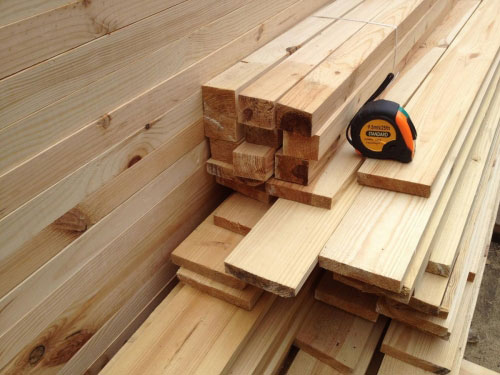
How to paint the lining: choosing a color scheme
As for the question: In what color to paint the lining?, then we can safely say that there is no unequivocal answer to it, and the choice of color scheme depends only on your preferences.
But, despite this, certain trends are dominated at a particular stage in the development of the design, and at the moment they are white leadership, which contributes not only to the visual expansion of the internal space, but also to increase the mood of residents.

